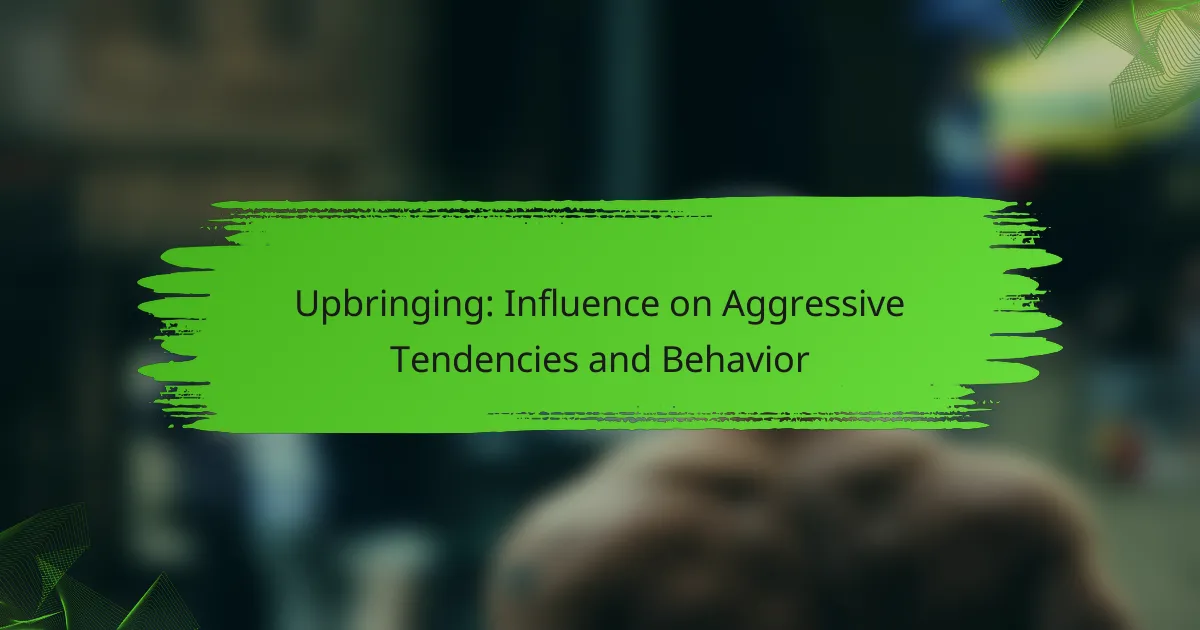Competitive sports often involve a complex interplay of aggression, performance, and rivalry, where aggression can enhance focus and drive but also pose risks like penalties and injuries. Rivalries further amplify this dynamic, motivating athletes to exceed their limits and achieve greater success. By managing their aggression through self-control techniques, athletes can harness their competitive energy for optimal performance.

How does aggression impact performance in competitive sports?
Aggression can significantly enhance performance in competitive sports by increasing an athlete’s focus and drive. However, it also carries risks, such as penalties and injuries, which can negatively affect outcomes.
Increased focus and determination
Aggression often leads to heightened focus and determination, enabling athletes to push their limits. This mental state can translate into improved performance, as competitors become more engaged and motivated during critical moments of a match or event.
For example, a soccer player who channels aggression may display greater tenacity in pursuing the ball, leading to more opportunities for scoring. This drive can be particularly beneficial in high-stakes situations where every second counts.
Risk of penalties and injuries
While aggression can boost performance, it also increases the likelihood of penalties and injuries. Athletes who play aggressively may commit fouls or engage in dangerous plays, resulting in penalties that can hinder their team’s performance.
In contact sports like football or hockey, aggressive behavior can lead to injuries, both for the player and opponents. Athletes should balance their competitive spirit with caution to avoid detrimental consequences that could sideline them or impact their team negatively.
Influence on team dynamics
Aggression can have mixed effects on team dynamics, fostering both camaraderie and conflict. On one hand, a shared aggressive mindset can unite team members, driving them to work together more effectively towards a common goal.
On the other hand, excessive aggression can lead to tensions within the team, particularly if individual players prioritize personal success over teamwork. Coaches should encourage healthy competition while promoting communication and collaboration to maintain a positive team environment.

What role does rivalry play in sports performance?
Rivalry significantly enhances sports performance by driving athletes to push their limits and achieve higher levels of success. The competitive nature of rivalries fosters a sense of urgency and determination, often resulting in improved outcomes during competitions.
Enhanced motivation and effort
Rivalries create a powerful motivational force that encourages athletes to invest more effort in their training and performance. When competing against a known rival, athletes often experience a surge in adrenaline and focus, which can lead to improved results. For instance, a football player may train harder in anticipation of a key match against a long-standing opponent.
This heightened motivation can manifest in various ways, such as increased practice hours or a stronger commitment to fitness regimens. Athletes may also set personal records when facing rivals, showcasing the impact of competitive spirit on performance.
Psychological effects on athletes
The psychological effects of rivalry can be profound, influencing both confidence and stress levels. Athletes may feel a heightened sense of pressure to perform well against rivals, which can lead to anxiety but also boost their competitive edge. This duality can be beneficial if managed correctly, as it may enhance focus and determination.
Moreover, rivalries can foster a strong sense of identity and belonging within a team or community. Athletes often draw strength from their supporters, which can alleviate some of the psychological burdens associated with competition.
Impact on fan engagement
Rivalries not only affect athletes but also significantly enhance fan engagement. Spectators are more likely to attend games and invest emotionally when they know a fierce rivalry is at play. This can lead to increased ticket sales and merchandise revenue, benefiting teams financially.
Fans often engage in discussions, social media interactions, and community events centered around rivalries, creating a vibrant culture that surrounds the sport. This engagement can elevate the overall experience of following a team, making rivalries a crucial aspect of sports entertainment.

How can athletes manage aggression effectively?
Athletes can manage aggression by employing techniques that promote self-control and focus. This involves understanding their emotional triggers and using specific strategies to channel competitive energy positively.
Mental conditioning techniques
Mental conditioning techniques help athletes prepare psychologically for competition. Visualization is a common method where athletes imagine successful performances, which can enhance confidence and reduce anxiety. Regular practice of mindfulness can also improve focus and emotional awareness, allowing athletes to respond to aggression constructively.
Breathing exercises are another effective technique. Simple practices like deep breathing can calm the mind and body, helping to manage aggressive impulses during high-pressure situations.
Use of sports psychology
Sports psychology provides valuable insights into managing aggression through tailored strategies. Working with a sports psychologist, athletes can identify personal triggers and develop coping mechanisms. Cognitive-behavioral techniques can help reframe negative thoughts that fuel aggression, promoting a more positive mindset.
Additionally, group sessions can foster a supportive environment where athletes share experiences and strategies, reinforcing healthy approaches to competition and rivalry.
Strategies for emotional regulation
Effective emotional regulation strategies are crucial for athletes to maintain composure. Techniques such as self-talk can help athletes stay focused and calm, replacing negative thoughts with positive affirmations. Setting specific performance goals can also provide direction, reducing the likelihood of aggressive outbursts when faced with challenges.
Practicing gratitude and reflection after competitions can enhance emotional resilience. Athletes should take time to evaluate their performance, recognizing both strengths and areas for improvement, which can mitigate feelings of frustration and aggression in future events.

What are the benefits of healthy competition?
Healthy competition fosters personal growth, enhances skills, and strengthens relationships among participants. It encourages individuals and teams to push their limits while maintaining respect for one another, leading to a more positive environment.
Improved skill development
Healthy competition drives individuals to refine their skills and techniques. Athletes often learn from their rivals, adopting new strategies and improving their performance through observation and practice.
For example, a basketball player might enhance their shooting accuracy by competing against a peer who excels in that area. Regularly engaging in competitive scenarios can lead to significant advancements in skill levels over time.
Stronger team cohesion
When teams engage in healthy competition, they often develop stronger bonds. Working together towards a common goal fosters trust and collaboration, which are essential for success.
Participating in team challenges or tournaments can help members understand each other’s strengths and weaknesses, ultimately enhancing communication and teamwork. This unity can translate into better performance during actual competitions.
Increased audience interest
Healthy competition can captivate audiences, drawing in fans and increasing engagement. Spectators are often more invested in events where they see athletes pushing their limits and striving for excellence.
For instance, a local soccer league that showcases competitive matches can attract larger crowds, boosting ticket sales and community support. This heightened interest can lead to increased sponsorship opportunities and funding for teams.

What are the risks of excessive aggression in sports?
Excessive aggression in sports can lead to significant risks, including physical harm to athletes and negative consequences for the overall sporting environment. It can compromise safety, diminish the spirit of fair competition, and result in lasting psychological issues for those involved.
Injury to self and others
High levels of aggression can increase the likelihood of injuries, both for the aggressive athlete and their opponents. For example, aggressive tackles in football or unchecked physicality in hockey can lead to serious injuries such as concussions or fractures.
Sports organizations often implement rules and penalties to curb aggressive behavior, but enforcement can vary. Athletes should prioritize safety and adhere to guidelines to minimize risks of injury during competition.
Negative impact on sportsmanship
Excessive aggression can erode sportsmanship, leading to unsportsmanlike conduct and a toxic competitive atmosphere. When athletes prioritize aggression over fair play, it can create hostility among competitors and diminish the enjoyment of the sport for both players and spectators.
Promoting respect and fair play is essential. Coaches and athletes should emphasize the importance of maintaining composure and respect for opponents, even in high-stakes situations.
Long-term psychological effects
Engaging in aggressive behavior can have lasting psychological effects, including increased anxiety, depression, and stress. Athletes who frequently resort to aggression may struggle with emotional regulation, impacting their mental health and overall well-being.
It is crucial for athletes to develop coping strategies and seek support when needed. Programs focusing on mental health and emotional intelligence can help mitigate these risks and promote healthier competitive practices.



